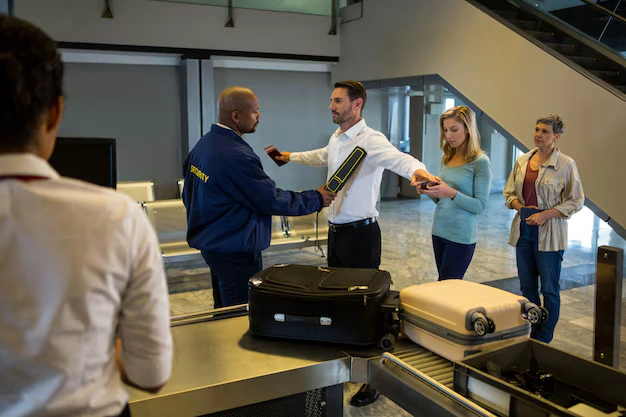Airports are crowded, high-traffic locations where large numbers of people congregate in a small space. They bustle with all manner of activity as passengers transit between terminals, airline staff labor behind the scenes, and airplanes take off and land in a steady stream. With this level of complexity, fire safety is a vital component of optimal airport operation. A fire can spiral out of control in an airport. Fires can destroy property, injure people, and halt operations. Hence, airports must implement robust fire safety measures to safeguard passengers, personnel and infrastructure. This article will elaborate on the significance of fire safety systems at airports, the fundamental elements of these systems, and best practices to ensure safety during an emergency.

1. Why Fire Safety is Important in Airports
Why Fire Safety Matters
From bustling terminals to baggage-handling areas and runways to aircraft hangars, airports have a diversity of spaces to put such a network to use. All of these areas are subject to various fire hazards, whether due to electrical apparatus, kitchen machinery, or even fuel storage spaces. The very nature of an airport—crowds of people and valuable assets—can make it a high-risk area for fires. Furthermore, fires in these ecosystems spread quickly, threatening lives. Proper fire safety education can prevent fires from developing to a stage when they cannot be controlled anymore. A properly prepared airport can reduce damage, facilitate quick evacuations and avoid loss of life.
Laws and Rules for Fire Safety
There are stringent fire safety laws and regulations in place for airports. These regulations are typically informed by standards established by international aviation organizations, such as the International Civil Aviation Organization (ICAO). Installation of fire detection systems, fire suppression systems, and evacuation routes are all clearly defined under the ICAO. These rules ensure that airports are serious about fire hazards and are prepared to respond in an emergency. They not only protect people but also enforce compliance with industry standards that can save lives and property.
The Importance of Fire Safety Systems in Saving Lives
Fire safety systems for every airport are designed to act quickly so that no disaster happens. If a fire is detected quickly, it can be contained quickly. Fire alarms and heat detectors, along with fire suppression systems, can prevent a fire from spreading. If a fire is quickly contained, it provides the best chance for passengers and crew members to evacuate with minimum loss of life. Fire safety systems are not just meant to prevent fires; they are also meant to protect people and keep airports running during emergencies.
2. Key Parts of Fire Safety Systems at Airports
Fire Detection and Alarm Systems
Smoke and Heat Detectors: Use smoke detectors throughout airport terminals and baggage handling areas. These detectors detect the first signs of smoke or fire and sound an alarm to alert everyone in the building. Heat detectors are used in places that can get hot: kitchens, mechanical rooms and electrical rooms. The reason is that heat detectors can pick up the temperature rise from a fire and activate alarms faster.
Aspirating Smoke Detection Systems (ASD): ASD systems use advanced technology to continuously suck the air from the environment and check the air for smoke. These systems are typically deployed in large spaces, such as terminal halls or aircraft hangars, where they can allow for rapid detection in moments of high traffic. Smoke detectors can sense minuscule levels of smoke, so they can alert us before we see or smell smoke.
Fire Suppression Systems
Once a fire has been identified, it then needs to be contained or put out before it gets out of control. Airports employ numerous fire suppression systems depending on the specific area and associated risks.
- Water-Based Systems: The sprinklers are prevalent throughout terminals, lounges, and the public spaces. These sprinklers are installed and are activated when a fire is detected, spraying water on the fire to control it. These systems are well-suited to combating fires that contain everyday materials—like paper, wood and upholstery.
- Foam-Based Systems: Foam-based systems are installed in high-risk zones such as hangars, refueling areas, aircraft parks, etc. Foam extinguishes fuel fires by coating the flames and depriving them of oxygen. Foam systems are also very effective in preventing the fire from restarting.
- Gas Suppression Systems: Gas suppression systems are a common type of fire suppression system utilized in sensitive environments like communication rooms, control towers, and data centers. These systems emit a specialized fire-extinguishing gas that extinguishes a fire without damaging costly electronics or equipment. Such a consideration is especially crucial to protecting means of transportation that, like every airport, are essential.
Fire Safety Equipment
Besides detection and suppression systems, airports also use other types of fire safety equipment that can assist in an emergency.
- Fire Extinguishers: Devices for fire extinguishing are located at specific points of the air terminal. Such places include kitchens, terminals and baggage areas.
- Emergency Lighting and Signs: In the event of a fire emergency, clear, visible signage and emergency lighting are important. These signs also direct many towards the nearest exits so they can evacuate quickly and safely. However, an emergency lighting system will light exit routes in the event the power goes out due to the fire.

3. Emergency Evacuation and Safety Plans
Evacuation Routes and Plans
If a fire does occur, it is important that all individuals know how to exit the airport in a safe and timely manner. Airports should also need well-defined and predetermined evacuation routes so that they can quickly evacuate with as little confusion or delay as possible.
- Signs Everywhere: There are exit signs throughout the airport leading people to the quickest, safest way out. These markings need to be clearly visible throughout the airport, but especially in their terminals, baggage areas, and inside of planes. Emergency lighting illuminates these exit paths even during a fire or power failure.
- Various Exit Routes: Airports need to offer several exit routes, especially in the heavily trafficked areas, to shorten the wait during an emergency. They have to be free of obstacles and wide enough to allow large groups of people to evacuate rapidly.
- Designated Safe Meeting Points: After an evacuation, it is imperative that passengers and staff assemble at a predetermined location outside of the airport. At an appropriate distance from the building so as not to be in any danger, these meeting points should also be close enough for easy roll call and accountability.

Supporting Passengers With Special Needs
Airports also need to accommodate passengers with disabilities or other special needs. These passengers might need additional support during an evacuation. Airport companies should have staff trained to assist passengers with mobility difficulties or plans in place for designated staff to help such travelers. Also, airports should offer additional features, like alarms that help people who are hearing impaired, or just other arrangements that will help ensure that the entire population can get out in a safe manner.
4. Fire Drills and Staff Training
Fire Drills
Fire drills are critical to ensuring that everyone knows what to do in the event of a fire emergency. Regular fire drills should be conducted by airports, wherein employees would drill themselves for different possible fire scenarios.
- Cover Different Scenarios: Exercises should include different situations, like fires in the terminals, baggage areas and onboard aircraft. Practicing various scenarios will help staff members respond appropriately to any fire emergency.
- Get everyone involved: Not only the security staff needs to participate in the fire drills; all of them, from the customer service personnel to the ground crew, should take part. Making sure everyone knows what they have to do will help the airport respond in the event of a real fire.
Training for Emergency Responders
Specialized training in the suppression of airport fires must be given to emergency responders at airports. They must be trained on the use of foam and water systems for firefighting equipment and for fires involving airplanes and hazardous materials. Frequent training allows responders the preparedness needed to handle any kind of fire emergency, regardless of the complexity.
FAQs
What fire systems are used in the airports?
Sprinklers, foam suppression systems and gas-based systems by airports control fire hazards, depending on the way.
How frequently should fire drills take place?
Regular fire drills need to take place, which, where appropriate, should be varied to cover different scenarios that members of staff might find themselves in.
What if there’s a fire at the airport?
If a fire does occur, the staff will follow evacuation procedures, instruct passengers to the exits, and meet outside while waiting for emergency responders to address the situation.
How could technology enhance fire safety at airports?
Technology, such as those involving IoT sensors and AI systems, contributes to enhancing fire safety. They can predict risks and optimize emergency responses.
Airport Fire Safety: Who’s in Charge?
Fire safety plans and equipment are established, maintained and operated by airport authorities and trained emergency responders.


